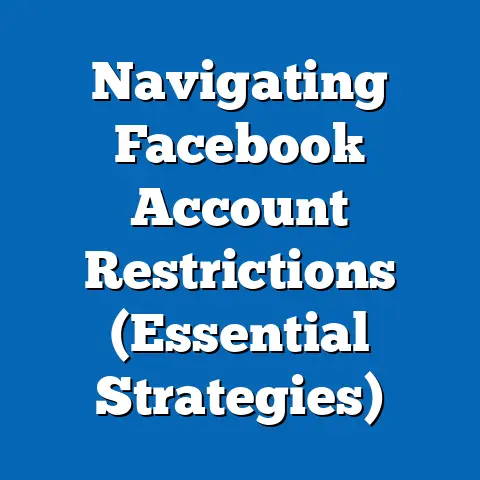Change Facebook Ad Currency & Timezone (Expert Guide)
Change Facebook Ad Currency & Timezone: An Expert Guide
In a world where global businesses can reach audiences in every corner of the planet with the click of a button, the notion of currency and timezone seems almost archaic. Yet, in the realm of Facebook advertising—where precision and relevance reign supreme—the choice of currency and timezone can make or break a campaign’s success. Think of it like this: you wouldn’t try to sell winter coats in July in Miami, right? Similarly, ignoring the currency and timezone nuances of your target audience is like throwing money into a black hole.
Introduction
Facebook, now known as Meta, remains a dominant force in the digital marketing landscape. With billions of active users, it offers unparalleled reach and targeting capabilities for businesses of all sizes. But the sheer power of Facebook advertising comes with a responsibility: to understand and optimize every aspect of your campaigns. While creative ad design and compelling copy are crucial, often the unsung heroes of successful campaigns are the seemingly mundane settings like currency and timezone.
Why are these settings so important? Well, your chosen currency directly impacts your budget allocation, reporting metrics, and even your ad delivery. Imagine running a campaign targeting users in Canada while your account is set to US dollars – you’re instantly introducing a layer of complexity (and potential errors) in your budgeting and reporting. Similarly, your timezone affects when your ads are shown, influencing engagement and ultimately, your return on investment (ROI).
Understanding Currency and Timezone in Facebook Ads
Let’s break down what these settings actually mean within the context of Facebook Ads Manager.
What are Currency and Timezone Settings?
- Currency: This setting dictates the currency in which you’ll be charged for your ad spend. It also affects how your budget is displayed in Ads Manager, making it easier to track your expenses and ROI.
- Timezone: This setting determines the reference point for scheduling your ads and analyzing performance data. It affects when your ads are shown to your target audience, based on their local time, and influences how you interpret your reports.
These settings are not just cosmetic; they have a direct impact on how your campaigns function and how you interpret their performance.
How These Settings Affect Your Campaigns
- Budget Allocation: Your chosen currency affects how Facebook allocates your budget. If your currency doesn’t match the local currency of your target audience, you might encounter discrepancies due to exchange rate fluctuations. This can lead to overspending or underspending in certain regions.
- Reporting Metrics: All your reporting metrics, such as cost per click (CPC), cost per acquisition (CPA), and return on ad spend (ROAS), are displayed in your chosen currency. This makes it easier to analyze your campaign performance and make informed decisions. However, if your currency is mismatched, you’ll need to manually convert the data, adding an extra layer of complexity.
- Ad Scheduling: Your timezone setting directly affects when your ads are shown to your target audience. If your timezone is set incorrectly, your ads might be shown at the wrong time of day, leading to lower engagement and wasted ad spend.
For example, I once worked with a client who was targeting users in Australia but had their timezone set to US Pacific Time. As a result, their ads were being shown during the middle of the night in Australia, leading to abysmal engagement rates. Once we corrected the timezone, their engagement rates skyrocketed.
Multi-Currency Support: Targeting Global Markets
Facebook Ads Manager offers multi-currency support, allowing you to target audiences in different countries with localized ad experiences. However, it’s crucial to understand how this feature works and how it interacts with your account’s default currency setting.
While you can target users in different countries, your account’s currency setting will still be the primary currency for billing and reporting. This means that you’ll need to be mindful of exchange rates and potential discrepancies when analyzing your campaign performance across different regions.
Takeaway: Currency and timezone settings are fundamental to the success of your Facebook ad campaigns. They affect your budget allocation, reporting metrics, and ad scheduling. Make sure to choose the right settings based on your target audience and business goals.
Why Change Currency?
Now that we understand the importance of currency settings, let’s explore some scenarios where changing your currency is not just beneficial, but essential.
Expanding into New Markets
One of the most common reasons to change your currency is when you’re expanding your business into new markets. Targeting users in a new country with your existing currency can lead to confusion and inaccuracies in your budgeting and reporting.
For example, if you’re based in the US and you’re starting to target users in the Eurozone, it makes sense to switch your currency to Euros. This will allow you to track your ad spend and ROI more accurately and avoid the hassle of manually converting your data.
Managing Budgets Effectively in Different Regions
Even if you’re already targeting multiple countries, you might need to change your currency to manage your budgets more effectively in different regions. This is especially true if you’re dealing with significant exchange rate fluctuations.
Imagine you’re running a campaign targeting both the US and Canada. If the Canadian dollar weakens against the US dollar, your budget allocation might be skewed towards the US, even if your target audience is equally distributed. By switching your currency to Canadian dollars for the Canadian campaign, you can ensure that your budget is allocated fairly and accurately.
Enhancing Financial Reporting Accuracy
Accurate financial reporting is crucial for any business, and your Facebook ad campaigns are no exception. Changing your currency to match the local currency of your target audience can significantly improve the accuracy of your financial reports.
By tracking your ad spend and ROI in the local currency, you can avoid the need for manual conversions and ensure that your financial data is consistent and reliable. This can be especially important if you’re working with external stakeholders, such as investors or auditors.
Common Currencies Used in Facebook Ads
Facebook Ads Manager supports a wide range of currencies, but some are more commonly used than others. Here are a few examples:
- USD (United States Dollar): The most widely used currency in Facebook Ads Manager.
- EUR (Euro): Commonly used for targeting audiences in the Eurozone.
- GBP (British Pound): Used for targeting audiences in the United Kingdom.
- CAD (Canadian Dollar): Used for targeting audiences in Canada.
- AUD (Australian Dollar): Used for targeting audiences in Australia.
The choice of currency depends on your target audience and your business goals. Make sure to choose the currency that best aligns with your overall marketing strategy.
Takeaway: Changing your currency is essential when expanding into new markets, managing budgets effectively in different regions, and enhancing financial reporting accuracy. Choose the currency that best aligns with your target audience and business goals.
Why Change Timezone?
Now, let’s shift our focus to timezone settings and explore why changing your timezone can be just as important as changing your currency.
Significance in Ad Scheduling
The timezone setting plays a crucial role in ad scheduling. It determines the reference point for when your ads are shown to your target audience. If your timezone is set incorrectly, your ads might be shown at the wrong time of day, leading to lower engagement and wasted ad spend.
For example, if you’re targeting users in Japan but your timezone is set to US Pacific Time, your ads might be shown during the middle of the night in Japan. This can significantly reduce your chances of reaching your target audience when they’re most active and engaged.
Impact on Performance Tracking
Your timezone setting also affects how you interpret your performance data. All your reporting metrics, such as impressions, clicks, and conversions, are displayed based on your chosen timezone. If your timezone is set incorrectly, you might misinterpret your data and make suboptimal decisions.
Imagine you’re running a campaign targeting users in both New York and Los Angeles. If your timezone is set to US Pacific Time, your data for New York will be shifted by three hours. This can make it difficult to accurately assess the performance of your ads in each region.
Impact on Audience Targeting and Engagement
The timezone setting can also impact your audience targeting and engagement. By setting the correct timezone, you can ensure that your ads are shown to your target audience when they’re most likely to be online and engaged.
For instance, if you’re targeting working professionals, you might want to show your ads during their lunch break or after work hours. By setting the correct timezone, you can ensure that your ads are shown during these peak engagement periods.
Scenarios Where Changing Timezone Makes Sense
- Seasonal Promotions: If you’re running seasonal promotions, such as holiday sales or summer campaigns, you might need to change your timezone to align with the local time of your target audience.
- Regional Campaigns: If you’re running regional campaigns, such as targeting users in a specific state or province, you might need to change your timezone to match the local time of that region.
- Specific Events: If you’re promoting a specific event, such as a concert or a conference, you’ll definitely want to ensure your timezone matches the event’s location.
Takeaway: Changing your timezone is essential for accurate ad scheduling, performance tracking, and audience targeting. Choose the timezone that best aligns with your target audience and your campaign goals.
Here’s a detailed, step-by-step guide on how to change your currency in Facebook Ads Manager. I’ll walk you through each step with clear instructions and screenshots (imagine them here!), so you can confidently make the change.Important Note: You can only change your currency when you don’t have any active ads running. This is a crucial point, so make sure to pause all your campaigns before proceeding.
- Access Ads Manager: First, log in to your Facebook account and navigate to Ads Manager. You can usually find it in the left-hand menu or by searching for “Ads Manager” in the search bar.
- Go to Billing: Once you’re in Ads Manager, click on the “Billing” tab. This is where you’ll find all your billing information, including your current currency setting. Sometimes, it’s hidden under a “Tools” menu.
- Find Payment Settings: Within the “Billing” section, look for “Payment Settings.” This is where you can manage your payment methods and update your currency.
- Create a New Ad Account: This is where it gets a little tricky. You cannot directly change the currency of an existing ad account. You need to create a new ad account with the desired currency. Click on “Create a new ad account.”
- Set Up Your New Ad Account: You will be prompted to enter information for your new ad account. This includes:
- Account Name: Choose a descriptive name for your new ad account.
- Timezone: Select the correct timezone for your target audience.
- Currency: This is the crucial step! Choose the currency you want to use for your new ad account.
- Business Information: Enter your business information, such as your address and tax ID.
- Save Your Changes: Once you’ve entered all the necessary information, click on “Save” to create your new ad account.
- Transfer Your Campaigns: Now, you’ll need to manually transfer your campaigns from your old ad account to your new ad account. This involves recreating your campaigns, ad sets, and ads in the new account.
- Close Your Old Ad Account (Optional): Once you’ve successfully transferred your campaigns and you’re confident that everything is working correctly, you can close your old ad account.
- Account Name: Choose a descriptive name for your new ad account.
- Timezone: Select the correct timezone for your target audience.
- Currency: This is the crucial step! Choose the currency you want to use for your new ad account.
- Business Information: Enter your business information, such as your address and tax ID.
Potential Pitfalls to Avoid:
- Active Ads: Remember to pause all your active ads before creating a new ad account.
- Data Loss: Transferring your campaigns manually can be time-consuming and there is a risk of data loss. Make sure to double-check everything to ensure that your campaigns are set up correctly in the new account.
- Learning Phase: When you transfer your campaigns to a new ad account, they will need to go through the learning phase again. This means that your performance might be slightly lower in the initial days.
Takeaway: Changing your currency in Facebook Ads Manager requires creating a new ad account. Follow these steps carefully to avoid potential pitfalls and ensure a smooth transition.
Step-by-Step Guide to Changing Timezone
Changing your timezone in Facebook Ads Manager is a much simpler process than changing your currency. You can directly update the timezone setting without creating a new ad account. However, like currency changes, it’s best to do this when you don’t have active campaigns.
- Access Ads Manager: Log in to your Facebook account and navigate to Ads Manager.
- Go to Ad Account Settings: In Ads Manager, click on the menu icon (usually three horizontal lines) and select “Ad Account Settings.”
- Find Timezone: In the “Ad Account Settings” section, you’ll find the “Timezone” setting.
- Edit Timezone: Click on “Edit” next to the “Timezone” setting.
- Select New Timezone: A dropdown menu will appear, allowing you to select your new timezone. Choose the timezone that best aligns with your target audience and campaign goals.
- Save Changes: Once you’ve selected your new timezone, click on “Confirm” to save your changes.
Important Considerations When Selecting a Timezone:
- Target Audience: Choose the timezone that best represents the location of your target audience.
- Campaign Goals: Consider your campaign goals and choose the timezone that will allow you to accurately track your performance data.
- Consistency: Maintain consistency across all your ad accounts and reporting tools.
Takeaway: Changing your timezone in Facebook Ads Manager is a straightforward process. Simply navigate to “Ad Account Settings” and select your new timezone.
Common Issues and Troubleshooting
Even with clear instructions, you might encounter some issues when changing your currency or timezone in Facebook Ads Manager. Let’s address some common problems and provide troubleshooting tips.
Currency Change Issues
- “You cannot change the currency of an existing ad account”: This is the most common issue. Remember, you need to create a new ad account to change your currency.
- “I’m seeing discrepancies in my reporting data”: This might be due to exchange rate fluctuations. Make sure to monitor your data closely and adjust your budgets accordingly.
- “My ads are not performing as well in the new ad account”: This is likely due to the learning phase. Give your campaigns some time to optimize and adjust your targeting or bidding strategies if needed.
Troubleshooting Tips:
- Double-check that you’ve paused all your active ads before creating a new ad account.
- Carefully transfer your campaigns to the new ad account, ensuring that all settings are correct.
- Monitor your data closely and adjust your budgets and targeting strategies as needed.
Timezone Change Issues
- “I’m not seeing the correct time in my reporting data”: Double-check that you’ve selected the correct timezone in your ad account settings.
- “My ads are not being shown at the correct time”: Review your ad scheduling settings and make sure they align with your new timezone.
Troubleshooting Tips:
- Verify your timezone setting in Ads Manager.
- Adjust your ad scheduling settings to reflect the new timezone.
- Use the “Ad Preview” tool to see when your ads will be shown to your target audience.
Facebook’s Policies Regarding These Changes
Facebook has specific policies regarding currency and timezone changes. It’s important to be aware of these policies to avoid any issues with your account.
- Currency Changes: As mentioned earlier, you cannot directly change the currency of an existing ad account. You need to create a new ad account.
- Timezone Changes: You can change your timezone at any time, but it’s best to do so when you don’t have active campaigns running.
- Account Restrictions: If you violate Facebook’s advertising policies, your account might be restricted or suspended. This can affect your ability to change your currency or timezone.
Case Studies:
I’ve seen countless clients benefit from strategically changing their currency and timezone settings. For example, I worked with an e-commerce company that was targeting users in Europe. By switching their currency to Euros, they were able to simplify their budgeting and reporting processes. This allowed them to focus on other aspects of their campaigns, such as creative ad design and audience targeting.
Takeaway: Be aware of common issues and troubleshooting tips when changing your currency or timezone in Facebook Ads Manager. Also, familiarize yourself with Facebook’s policies regarding these changes to avoid any issues with your account.
The Future of Facebook Advertising Currency and Timezone Management
Looking ahead, what can we expect from Facebook (Meta) in terms of currency and timezone management? While I can’t predict the future with certainty, I can speculate on some potential developments based on current trends and industry insights.
Potential Future Developments
- More Flexible Currency Options: Facebook might introduce more flexible currency options, allowing advertisers to target users in different countries with different currencies within the same ad account.
- Automated Timezone Optimization: Facebook might develop algorithms that automatically optimize your timezone settings based on your target audience and campaign goals.
- Integration with Cryptocurrency: With the rise of cryptocurrency, Facebook might explore the possibility of integrating cryptocurrency payments into its advertising platform.
Emerging Trends
- Rise of Decentralized Finance (DeFi): The rise of DeFi could lead to new ways of managing and tracking ad spend, potentially bypassing traditional currency systems.
- Changes in Global Trade Dynamics: Changes in global trade dynamics could influence how advertisers set their currency and timezone settings, especially when targeting emerging markets.
Takeaway: The future of Facebook advertising currency and timezone management is likely to be shaped by emerging trends and technological advancements. Stay informed and be prepared to adapt your strategies accordingly.
Conclusion
Remember, the world of digital marketing is constantly evolving. As new technologies emerge and consumer behaviors shift, it’s crucial to stay informed and adapt your strategies accordingly. By mastering the fundamentals and embracing innovation, you can unlock the full potential of Facebook advertising and achieve your business goals.
So, go forth and conquer the digital landscape, armed with the knowledge of currency and timezone optimization! And remember, the best marketer is always learning.






